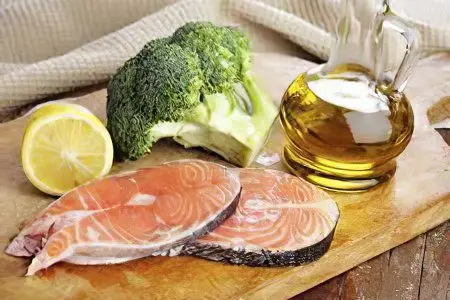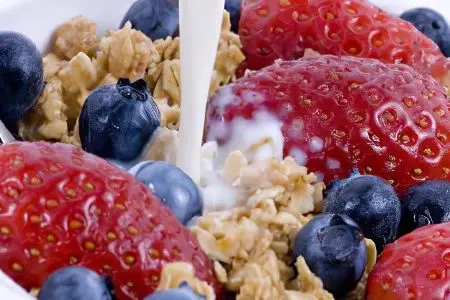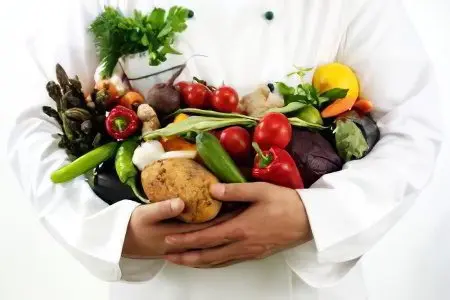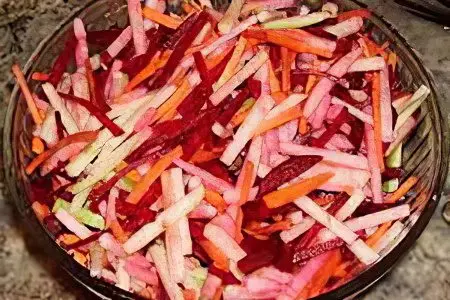Contents
What can you eat with cholecystitis?
The development of inflammation of the gallbladder is directly related to the characteristics of nutrition, so a rational diet becomes a prerequisite for the treatment of the disease and well-being. It should contain all the useful substances necessary for the body, contribute to the dilution of bile and the elimination of inflammation. It is advisable to choose the method of cooking that has the least burden on the digestive organs.
The list of products allowed for cholecystitis includes:
Low-fat poultry and meat, seafood, fish, premium sausage products that do not contain spicy spices and lard. You can eat no more than 1 chicken yolk daily.
Fresh non-acidic fruits, vegetables and a variety of greens. These foods are valuable sources of vitamins, dietary fiber and trace elements. Pears are especially useful for cholecystitis, they contribute to recovery, so their consumption can be increased.
The diet may include cereals, especially oatmeal and buckwheat, as well as pasta. From them you can cook cereals, puddings and casseroles.
Low-fat dairy products and non-acidic, such as low-fat cottage cheese, sour cream, low-fat cheeses. Yoghurts with bifidobacteria will serve as a prevention of intestinal dysbacteriosis.
Bread is recommended to be consumed in a dried or slightly stale form, giving preference to grain bakery products and products with bran. Unsavory cookies are allowed.
Natural vegetable oils that have not been refined, olive oil is especially useful.
From the sweet, you can afford marshmallows, jam, marmalade.
Drinks – rosehip broth, kissels, sweet fruit compotes and juices, coffee with milk and weak tea. Drinking beetroot juice half a glass twice a day significantly reduces the risk of painful attacks with cholecystitis. The consumption of chicory has a beneficial effect on the state of the gallbladder, so it is recommended to include drinks from it in the diet.
The use of turmeric in cooking will stop the inflammatory processes in the gallbladder and increase the removal of bile.

What can not be eaten with cholecystitis?
People who suffer from this disease should avoid foods that irritate the mucous membranes, increase cholesterol and make digestion difficult. Saturated fats are strictly prohibited.
Products, the use of which is prohibited for patients with cholecystitis:
Fatty pork, lamb, goose, duck, high-fat fish, lard, liver and kidney.
Peas, beans and other legumes.
Sour fruits and berries
Radish, spinach, sorrel, onion, garlic, whose essential oils irritate the walls of the stomach.
Mushrooms will also have to be abandoned.
Canned food, caviar (fish), smoked products, marinades.
Pastry products, pastries, especially fresh ones, cocoa products, chocolate, ice cream, fat cream.
Spices, vinegar, spicy sauces and rich meat, and even fish broths, fried foods.
It is not recommended to drink alcohol, carbonated drinks and strong coffee.
Horseradish and mustard should be excluded from the menu.
Excessive consumption of sugar leads to a deterioration in the composition of bile and a violation of bile secretion, so its daily intake should not exceed 70 g, taking into account its content in dishes, which is about 9 teaspoons. The permissible amount of salt intake does not exceed 10 g.
Can honey be used for cholecystitis?
Honey contains many useful substances that have a beneficial effect on the state of the body as a whole, but for people with cholecystitis, it will be especially valuable for its choleretic effect. It is not only included in the diet, but is also used as a remedy. To this end it is recommended to drink in the morning on an empty stomach 100 g of water with a tablespoon of honey dissolved in it, lie down on the right side and place a pre-prepared heating pad under you. In this position, you need to stay for about 3 minutes. You need to repeat the procedure within 5 days. This measure will allow you to expel all the bile accumulated there during the night from the biliary tract.
For the prevention and relief of the condition with calculous cholecystitis, it is recommended to eat boiled corn cobs with honey.
Menu for cholecystitis

When compiling a daily menu, it is necessary to take into account some of the rules inherent in the diet for cholecystitis:
The total daily volume of food should not exceed 3,5 kg, taking into account the fluid consumed.
Meals should be frequent, 5 times a day at a strictly set time, but portions should not be made large. Such a measure will improve the outflow of bile and regulate its production.
Three main meals are interspersed with two additional meals, in which sandwiches, fruits and allowed drinks can be used as a snack.
It is important to choose the right method for cooking. Boiling and steaming are preferred, baking is allowed, but in this case additional fat or oil should not be used.
So that the extractives in meat and fish do not irritate the liver, these products are steamed or in water. The resulting broth should not be eaten during an exacerbation of cholecystitis, and occasionally during remission. Before cooking, the meat is cleaned from films and tendons, and the bird is freed from the skin.
Vegetable oils have a choleretic effect, but they can only be added to the finished dish and it is forbidden to expose them to heat in order to avoid losing their beneficial properties.
The temperature of food before eating should be moderate (not less than 15 ° C and not more than 62 ° C), too hot or cold food can provoke an attack.
Vegetables are recommended to be consumed raw and cooked with every meal. Fruits must be included in the daily menu, especially avocados.
For cooking, you can use only fresh and natural products.
An example of a weekly menu for people suffering from cholecystitis:
Monday
1 breakfast – oatmeal with sausage, rosehip broth or tea.
2 breakfast – banana with 100 grams of low-fat cottage cheese.
Lunch – vegetable soup with wheat groats, peppers stuffed with meat and rice, rosehip broth or compote.
Snack – salad with tomato and cucumber, seasoned with vegetable oil, a slice of bread made from rye flour.
Dinner – milk rice soup, 3 pcs. unhealthy cookies.
Tuesday
1 breakfast – cottage cheese casserole with raisins (150 g), coffee with milk.
2 breakfast – apple and pear salad, watered 1 hour. l. honey sprinkled with crushed nuts.
Lunch – buckwheat porridge with a steam cutlet, seaweed, compote.
Snack – baked apple, jelly.
Dinner – vinaigrette, protein omelet from greens and 1 egg.
Wednesday
1 breakfast – lazy dumplings (200 g), rosehip broth.
2 breakfast – sandwiches with zucchini caviar – 2 pcs.
Lunch – vegetable puree soup, seasoned with herbs and olive oil, boiled chicken leg, compote.
Snack – a salad made from carrots and apples, sprinkled with honey.
Dinner – macaroni and cheese, tea.
Thursday
1 breakfast – semolina porridge with a spoonful of jam, tea with milk.
2 breakfast – a slice of grain bread, a protein omelet from greens and 1 egg.
Lunch – mashed potatoes, low-fat boiled fish, tomato, poured with vegetable oil and sprinkled with herbs.
Snack – tea and marshmallows.
Dinner – fruit pilaf, rosehip broth.
Friday
1 breakfast – millet porridge, boiled doctor’s sausage (50 g), coffee with milk.
2 breakfast – baked pumpkin (150 g), rosehip broth.
Lunch – stewed cabbage (200 g), beef stroganoff (100 g), bread with bran.
Snack – a slice of cheese, tea with milk.
Dinner – vegetable stew (200 g), grain bread.
Saturday
1 breakfast – vermicelli milk soup, 2 dryers, tea.
2 breakfast – vegetable casserole (150 g), rosehip broth.
Lunch – vegetarian soup, boiled beef (100 g), compote.
Snack – Adyghe cheese (50 g), tomato with herbs.
Dinner – fish boiled and baked with vegetables (200 g), rosehip broth.
Sunday
1 breakfast – puff pastry meat pie (150 g), coffee with milk.
2 breakfast – 2 handfuls of dried fruits, tea.
Lunch – pilaf with boiled meat (200 g), salad of cucumber, cabbage and greens (100 g).
Snack – a slice of grain bread, covered with curd cheese with herbs, tea.
Dinner – pumpkin porridge, milk.
The menu can be modified to reflect permitted products.
Recipes for dishes and soups with cholecystitis

Squid, Cucumber and Brussels Sprouts Soup:
Squid, Brussels sprouts (200 g), cucumbers (200 g), herbs, vegetable broth (700 ml), salt.
Preparation: peel the squid and cut into thin strips, boil the broth, put the cabbage, cook for 5 minutes. Add prepared seafood, diced cucumbers to the pan, salt and cook for 4 minutes. Sprinkle the finished soup with chopped herbs.
vegetable puree soup
Zucchini (2 pcs.), Eggplant (2 pcs.), Carrots (2 pcs.), Bell peppers (2 pcs.), Onion (2 pcs.), Large potatoes (5 pcs.), Olive oil (2 tbsp. l.), salt, herbs.
Preparation: peel and cut vegetables into cubes, remove the skin from the pepper, chop the onion. Dip the potatoes in 3 liters of boiling salted water, after 10 minutes add the rest of the vegetables, excluding zucchini, they are added 5 minutes before turning off. Ready, slightly cooled soup is whipped with a blender, seasoned with olive oil and herbs.
Potato, broccoli and beetroot soup
Beets (100 g), potatoes (100 g), broccoli (200 g), vegetable broth (650 ml), salt.
Preparation: boil the broth over low heat, add potatoes, beets cut into small pieces, separate the inflorescences from broccoli and dip in water, salt. The soup should be boiled until the vegetables are soft.
Soup with beets, kohlrabi and mussels
Mussel meat (220 g), beets (150 g), kohlrabi (150 g), herbs, vegetable broth (750 g), salt.
Preparation: chop the kohlrabi, chop the beets, dip into the boiled broth and cook until soft, then salt, add the mussel meat and wait 6 minutes. Sprinkle the finished soup with herbs.
Beef cutlets with vegetables
Cauliflower (400 g), beef (600 g), egg, carrot (150 g), butter (50 g), cheese (15 g), flour (tablespoon), sour cream (100 g), a little salt.
Preparation: boil the beef and cut into small pieces, carrots into cubes, disassemble the cabbage into inflorescences. Mix the meat with vegetables, add salt, pass the mass through a meat grinder, add an egg, knead the minced meat. From it, form cutlets, put on a frying pan wiped with oil, pour sour cream, sprinkle with cheese and bake.
Fish Soufflé
Milk (30 g), fish (90 g), flour (2 g), egg, salt, butter (2 g).
Preparation: boil the fish fillet, grind in a meat grinder, add the yolk, milk, salt, oil to the mass, mix everything. Beat the protein thoroughly and add to the main products. Put the resulting mass into an oiled frying pan and bake at 180 ° C. You can place the souffle in prepared molds and steam.
Stuffed pepper
Large sweet peppers (6 pcs.), Lean beef or chicken fillet (500 g), boiled rice (3 tbsp.), Onion (2 pcs.), Tomato juice (1 tbsp.), Garlic (2 cloves), bay leaf, paprika, salt.
Preparation: peel the pepper and chop in several places, make minced meat, add spices, rice and chopped garlic to it. Chop the onion, grate the carrots, simmer them in water until soft, then pour in the tomato juice and boil. Put the minced meat tightly in the pepper, place the pods on a baking sheet, put the fry on top, add water and bake for about 40 minutes.
Salads for cholecystitis

Vegetable Salad
Cucumber (1 pc.), Tomato (1 pc.), Pepper (1 pc.), Lettuce, greens, corn or olive oil, salt.
Preparation: cut vegetables into large pieces, add lettuce leaves, herbs, season with oil, salt.
Cabbage salad
White cabbage (220 g), carrots (25 g), sugar (2 g), salt, vegetable oil (10 g), citric acid 2% (10 g).
Preparation: finely chop the cabbage, grind with citric acid and salt, squeeze out the juice, add sugar, grate the carrots, add to the bulk and season with oil.
Sweet beet salad with dried apricots
Beets (900 g), dried apricots (100 g), sour cream (150 g), sugar (20 g).
Preparation: soak dried apricots for half an hour and finely chop, boil the beets and chop into strips, mix the ingredients, season with sour cream and sprinkle with sugar.









